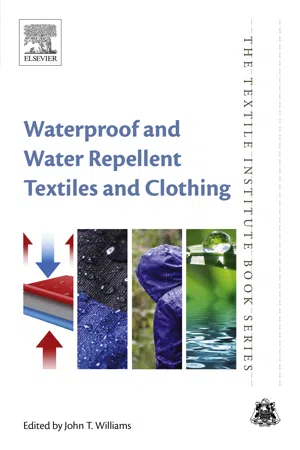1.1 Introduction
Protection against environmental factors is the initial function of clothing. In a wet environment, the basic requirement for garments is to keep the wearer dry by being waterproof and or water repellent. The difference between the two terms is essential when characterizing the behaviour of textile materials in reference to liquid water. In contact with water, water repellent materials form drops that can be easily removed from the fabric surface but for longer contact with water or with a higher pressure difference, the material will absorb water. Water repellent textiles are often high density woven materials made of very fine yarns or common materials with hydrophobic surface treatment. Waterproofing is defined as the property of a material not to be penetrated by fluids. The waterproofness of a fabric can be measured using two testing methods: one that simulates raining and the other (more common) that subjects the fabric to hydrostatic pressure. The minimum value for the hydrostatic pressure without leaking at its surface, at which a fabric is considered rainproof is 5000 mm water column, while for waterproof materials the hydrostatic pressure can reach 10,000–15,000 mm water column (Loghin, 2003). For high quality waterproof materials designed for aggressive conditions, the hydrostatic pressure varies between 15,000 and 30,000 mm water column. Such fabrics are completely waterproof even under very high pressure.
First historical mentions regarding the hydrophobization of textiles are in the 15th century, when sailors tried to obtain sea water protective clothing by impregnating it with linseed oil, animal fat or wax. The first bio-inspired waterproof clothing product (kamleika) belongs to Aleut American Indians who used dried seal or whale intestines; the seams have been sealed with animal glues to make the product totally waterproof (Lynch and Strauss, 2015).
The first waterproof fabric was produced and patented by Charles Macintosh in 1823 in England (Shephard, 2012). The process to produce waterproof materials involves the spreading of a rubber layer between two woven fabrics. The problems related to the use of garments made of this material, caused by the unstable rubber, were eliminated by the process of rubber vulcanization that led to a textile material more stable in environmental conditions. The process was patented in 1844 by Charles Goodyear in the United States, and Thomas Hancock in England.
For a long period, rubberized textile fabrics were the raw material for waterproof garments. The main problem with these garments is reduced comfort due to the overheating of the wearer's body and high resistance to vapour passing out through the clothing layers. The sweat vapours condense in contact with the interior surface of the clothing, humidifying the textile layers in direct contact with the skin and causing increased discomfort. Subsequent researches conducted in the production of waterproof textiles led to a new type of material, waterproof-breathable fabrics.
Ventile fabrics are waterproof, breathable, densely woven materials developed in the UK during WWII to replace flax in garments for outdoor, military, medical and work wear applications. The first microporous membrane (polytetrafluoroethylene PTFE, also known as Teflon) was created in 1969 by W. L. Gore and Associates. The first GORE-TEX materials appeared on the market in 1976, starting a revolution in the concept of waterproof-breathable garments.
Water repellent textiles are obtained using specific finishing surface treatments. A review by Schuyten et al. (1948) shows that these hydrophobic treatments were developed significantly starting with 1920s.
Waterproof-breathable textiles represent a significant global market, with major players from the US, Europe and Asia. A press release for a report from Grand View Research Inc. (2016) indicates the value of the waterproof breathable textiles market in 2014 was $1.43 billion. Membrane waterproof-breathable products account for 71% of the overall demand, while garments remain the main application. The report anticipates a constant growth of this market, stimulated by the need for comfortable multifunctional products, the use of innovative technologies to produce biomimetic and smart textiles, and the focus on recyclable and eco-friendly products. With an estimated compound annual growth rate (CAGR) over 5% per annum, the market of waterproof-breathable textiles is expected to reach $2.18 billion by 2020.
1.2 Areas of application of waterproof and water repellent textiles
Waterproof and water repellent materials are currently used in the three major textile areas (clothing, home and outdoor products and technical textiles). There are a large number of possible applications, from rain garments to medical and military equipment (Singha, 2012). Regardless of the applications for which waterproofness is the determinant function, the complexity of the conditions during use requires the multicriterial design of the fabric structure and its testing to ensure a high number of functional characteristics such as: vapour permeability, tensile strength, abrasion resistance, flexural strength (repeated cycles), resistance to low and high temperatures, resistance to light, chemical resistance and more.
Several standards are used for the evaluation of waterproof-breathable and water repellent textiles.
Waterproofness is measured as the hydrostatic pressure needed to penetrate the waterproof-breathable fabrics. The standards used for determining waterproofness are:
– ASTM D 3393-91 Standard Specification for Coated Fabrics—Waterproofness.
– AATCC TM 127-water resistance: hydrostatic pressure test.
– ISO 811 Textile fabrics—Determination of resistance to water penetration—Hydrostatic pressure test.
– BS 3424-26 Testing coated...
